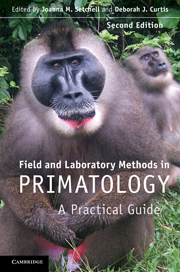Book contents
- Frontmatter
- Contents
- List of contributors
- Foreword by Robert D. Martin
- Introduction
- 1 An ethnoprimatological approach to interactions between human and non-human primates
- 2 Habituating primates: processes, techniques, variables and ethics
- 3 Habitat description and phenology
- 4 Geographical information systems and remote sensing
- 5 Monitoring local weather and climate
- 6 Survey and census methods: population distribution and density
- 7 Trapping primates
- 8 Handling, anaesthesia, health evaluation and biological sampling
- 9 Morphology, morphometrics and taxonomy
- 10 Marking and radio-tracking primates
- 11 Field experiments with non-human primates: a tutorial
- 12 Feeding ecology, frugivory and seed dispersal
- 13 Dietary analysis I: food physics
- 14 Dietary analysis II: food chemistry
- 15 Collecting arthropods and arthropod remains for primate studies
- 16 Recording primate vocalizations
- 17 Photography and video for field researchers
- 18 Chronobiological aspects of primate research
- 19 Thermoregulation and energetics
- 20 Field endocrinology: monitoring hormonal changes in free-ranging primates
- 21 Collection, storage and analysis of non-invasive genetic material in primate biology
- 22 Tips from the bush: an A–Z of suggestions for successful fieldwork
- Index
- References
15 - Collecting arthropods and arthropod remains for primate studies
Published online by Cambridge University Press: 05 June 2012
- Frontmatter
- Contents
- List of contributors
- Foreword by Robert D. Martin
- Introduction
- 1 An ethnoprimatological approach to interactions between human and non-human primates
- 2 Habituating primates: processes, techniques, variables and ethics
- 3 Habitat description and phenology
- 4 Geographical information systems and remote sensing
- 5 Monitoring local weather and climate
- 6 Survey and census methods: population distribution and density
- 7 Trapping primates
- 8 Handling, anaesthesia, health evaluation and biological sampling
- 9 Morphology, morphometrics and taxonomy
- 10 Marking and radio-tracking primates
- 11 Field experiments with non-human primates: a tutorial
- 12 Feeding ecology, frugivory and seed dispersal
- 13 Dietary analysis I: food physics
- 14 Dietary analysis II: food chemistry
- 15 Collecting arthropods and arthropod remains for primate studies
- 16 Recording primate vocalizations
- 17 Photography and video for field researchers
- 18 Chronobiological aspects of primate research
- 19 Thermoregulation and energetics
- 20 Field endocrinology: monitoring hormonal changes in free-ranging primates
- 21 Collection, storage and analysis of non-invasive genetic material in primate biology
- 22 Tips from the bush: an A–Z of suggestions for successful fieldwork
- Index
- References
Summary
INTRODUCTION
Arthropods, along with other invertebrates, make up 95% of the global fauna, with 1.5 million described species and at least a further 10 million that remain undescribed. These organisms, which include insects, arachnids and myriapods, play a significant role in the life histories of a range of primate species, not least in their diet. Body size plays an important part in determining the degree of insectivory (Kay, 1984); however, examples of insect eating can be found within all lineages of the primate phylogeny. Many strepsirrhines have long been described as insectivores, some having morphological adaptations for insect feeding (e.g. the extractive finger of the aye aye, Daubentonia madagascariensis) and others adopting behaviours such as aerial snatching (e.g. galagos, Galago demidovii), or stalking specific arthropod prey (e.g. angwantibos, Arctocebus calabarensis) (Charles-Dominique, 1974). Some lorisids, like the potto (Perodicticus potto), have evolved specialized diets, feeding on arthropods that emit distasteful chemicals (e.g. formic acid from ants: Crematogaster spp.) or have the potential to inject venom (e.g. large scolopendrid centipedes: Spirostreptus spp.) (Charles-Dominique, 1974). Within the anthropoids, chimpanzees (Pan troglodytes) use tools to help eat insects such as bees (Apis spp.) and the honey they produce (Tutin & Fernandez, 1992). Even folivores inadvertently eat thousands of insects a day (e.g. mountain gorillas, Gorilla beringei beringei, and langurs, Semnopithecus entellus). However, apart from the large patas monkey (Erythrocebus patas), anthropoid primates are unable to process enough arthropod material for these animals to form a major part of a higher primate's diet (Isbell, 1998).
- Type
- Chapter
- Information
- Field and Laboratory Methods in PrimatologyA Practical Guide, pp. 271 - 286Publisher: Cambridge University PressPrint publication year: 2011
References
- 1
- Cited by



